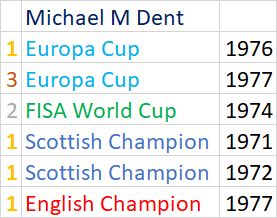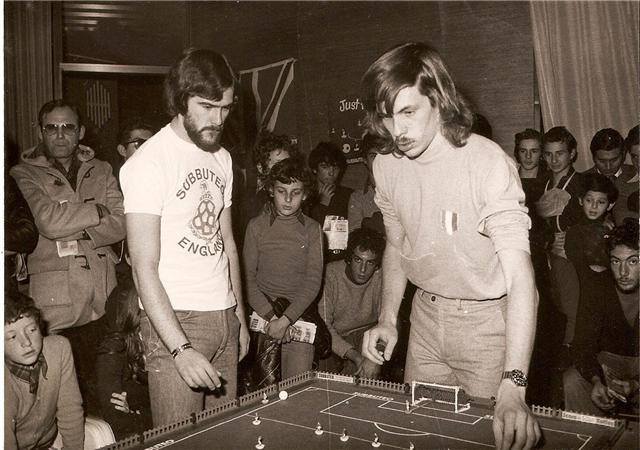The name Michael Dent may not mean much to the younger generation of players, especially those outside Europe.
But during the mid 70s he was one of a crop of top British players who made their name on the European Cup.
Now living and working in Malaysia, as a lecturer in marketing management, Mike occasionally flicks and has helped the local organiser, and has taken part in events in Singapore. He is hoping to attend the Asian Cup in Melbourne in January 2018.
![]() When did you start playing? How did you get involved?
When did you start playing? How did you get involved?
![]() I was invited to a friend’s house in Sheffield when I was 12 years old and he played the game on the floor. I only saw it the once and shortly afterwards moved back to Scotland with my mother and sister. This was in 1966, that year Sheffield Wednesday lost the FA Cup Final 2-3 to Everton despite having a 2-0 lead, England won the World Cup and the following year Jim McCalliog of Sheffield Wednesday scored the winning goal for Scotland against England at Wembley. So a lot of my footballing affiliations were forged at that time.
I was invited to a friend’s house in Sheffield when I was 12 years old and he played the game on the floor. I only saw it the once and shortly afterwards moved back to Scotland with my mother and sister. This was in 1966, that year Sheffield Wednesday lost the FA Cup Final 2-3 to Everton despite having a 2-0 lead, England won the World Cup and the following year Jim McCalliog of Sheffield Wednesday scored the winning goal for Scotland against England at Wembley. So a lot of my footballing affiliations were forged at that time.
I ordered some basic kit (pitch, goals, balls and 2 Continental OO Scale teams) from Subbuteo in Tunbridge Wells and started playing with my sister. She soon lost interest so I enlisted a few new school friends and before long we decided to start a league. The others just marked out a pitch on a sheet of cotton which again we laid on the carpet. So we had to shuffle round the pitch on hands and knees, a lot of players got broken that way when we were not paying close attention.
Scotland in the winter was pretty cold and one of my friends played in the front living room which had no heating, so I got used to frozen fingers and techniques of trying to warm/revive them at half time.
I think I played in my first Scottish Championship in 1967/8. I only played 2 or 3 games in a group and finished 2nd. I noticed that all of the good players played with flat figures and a large ball. So I took note and ordered myself lots of sets of plastic and cardboard flat figures and bases. My Continental teams were consigned to the back of my cupboard.
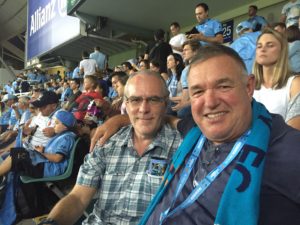
Mike and Steve in Sydney in 2016
![]() What was your first club/tournament?
What was your first club/tournament?
![]() My first club was the Blairgowrie TSL in Perthshire in Scotland, this was comprised of fellow pupils at Blairgowrie High School. There were 8 or 9 of us in the league which I played in until I returned to England in 1969 to live with my father and go to college.
My first club was the Blairgowrie TSL in Perthshire in Scotland, this was comprised of fellow pupils at Blairgowrie High School. There were 8 or 9 of us in the league which I played in until I returned to England in 1969 to live with my father and go to college.
I dominated this particular club but in order to improve my standard of play I decided to also join the Perth league some 20 miles away along with my friend Garry. This was a tough proposition as the games were played in an upstairs room of the Cross Keys pub on a Monday night. If I missed the last bus home (about 10pm) it was a long walk back, and even then I still had two miles to walk back to my house up a steep hill. As it was we only missed the bus once and then had the luck to be picked up by a passing police car after only about 3 or 4 miles. I only played in the league one year and finished runner-up despite being undefeated all season.
All of the players here used the small ball and OO scale figures (as they were then called). However, they used proper pitches mounted on a board on a table. Learning from that I too had my own chipboard pitch made by a local carpenter and started to practice regularly in the spare room that we had at home. The fact that I was able to practice every day I am sure was what provided the basis for my future success.
One of the problems was the somewhat biased refereeing coupled with my flat figures tendency to fall down when flicked. In one game against my main rival I played the ball in the penalty area with one of my figures who fell over and was left still touching the ball. The referee gave a penalty for handball and I was 1-0 down! I managed to recover with a second half goal and we ended up drawing 1-1.
![]() Who was your toughest opponent?
Who was your toughest opponent?
![]() My most difficult opponent was Dave Collett. He never seemed to lose possession and even in my own penalty area it seemed impossible to get the ball off him. I never really got to grips with how to beat him. Stuart Goldman was one of my best friends (he was English Champion in 1972). He died when he was still very young. However, his analysis of other people’s games was second to none and he was able to help me handle different playing styles. In particular he told me how to handle the very fast approach play of Norman Gleave. Oddly enough, despite his analytical skills he did not have the patience or discipline to put his suggested methods into practice himself. He played (a bit like West Ham of old) purely for the fun of the game. In this way he was very much like his mentor Ron Russ. Ron, Stewart and Colin Vickers (another good friend of mine) all played in the Waltham Forest Table Football league which was played above one of Ron’s pharmacies in Leyton (East London).
My most difficult opponent was Dave Collett. He never seemed to lose possession and even in my own penalty area it seemed impossible to get the ball off him. I never really got to grips with how to beat him. Stuart Goldman was one of my best friends (he was English Champion in 1972). He died when he was still very young. However, his analysis of other people’s games was second to none and he was able to help me handle different playing styles. In particular he told me how to handle the very fast approach play of Norman Gleave. Oddly enough, despite his analytical skills he did not have the patience or discipline to put his suggested methods into practice himself. He played (a bit like West Ham of old) purely for the fun of the game. In this way he was very much like his mentor Ron Russ. Ron, Stewart and Colin Vickers (another good friend of mine) all played in the Waltham Forest Table Football league which was played above one of Ron’s pharmacies in Leyton (East London).
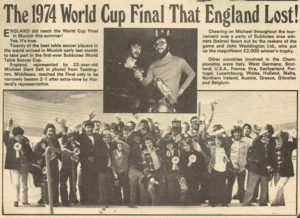
![]() What was your favourite win?
What was your favourite win?
![]() This is an easy question – the Europa Cup final in Malta in 1976. I knocked out the reigning champion Peter Czarkowski (West Germany) in the group stages, survived a nasty scare against a local Maltese player in the Quarter Finals and then ended up playing Norman Gleave in the final. At that time no British player had ever won the Europa Cup so whichever way it went history was going to be made. (Gleave had lost the final the previous year to Czarkowski 2-1 in Haibach, West Germany).
This is an easy question – the Europa Cup final in Malta in 1976. I knocked out the reigning champion Peter Czarkowski (West Germany) in the group stages, survived a nasty scare against a local Maltese player in the Quarter Finals and then ended up playing Norman Gleave in the final. At that time no British player had ever won the Europa Cup so whichever way it went history was going to be made. (Gleave had lost the final the previous year to Czarkowski 2-1 in Haibach, West Germany).
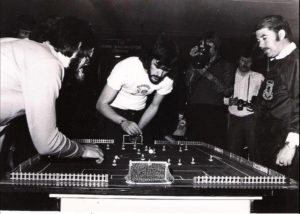
World Cup final v Dick Rietveld with Mike Thomas as referee
I went 1-0 up and unlike the World Cup Final the year before where I lost due to nerves (going 1-0 up in the last minute and still managing to lose to Dick Rietveld of the Netherkands) I remained ice cool. I learned from the previous year’s defeat and defended well and a break away saw me notch a second. All the other matches for places where going on at the same time so very few people actually watched our game, although I believe it was shown on Maltese TV. I was never able to obtain the footage.
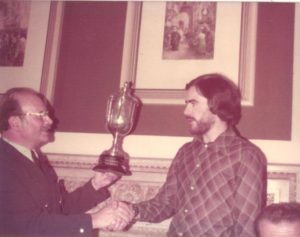
The big one – The Europa Cup, oddly enough presented by the SSG Commercial Director David Morrison-Wilpred in Malta in 1976
One thing that today’s readers may not be aware of was that the Europa Cup was the most coveted trophy in the world. And the Subbuteo World Cup was seen merely as a commercial promotional event mainly targeted at younger players.
![]() How did you see the development of the game?
How did you see the development of the game?
![]() Clearly the advent of Nintendo, Playstation and ever more realistic virtual games Table Soccer has a big challenge. The benefits I think come from the social aspects of the game and the eye/hand co-ordination skills required which are all very important for young people. Older teens and young adults also gain from national and international tournaments where they get the chance to play and interact with players of other countries, cultures and religions which broadens the mind. When I was playing television could not cope with the small scale and speed of the game, nowadays they seem to have mastered the trick, so this can help.
Clearly the advent of Nintendo, Playstation and ever more realistic virtual games Table Soccer has a big challenge. The benefits I think come from the social aspects of the game and the eye/hand co-ordination skills required which are all very important for young people. Older teens and young adults also gain from national and international tournaments where they get the chance to play and interact with players of other countries, cultures and religions which broadens the mind. When I was playing television could not cope with the small scale and speed of the game, nowadays they seem to have mastered the trick, so this can help.
![]() Did you always play with flats? Did you ever try other figures?
Did you always play with flats? Did you ever try other figures?
![]() This is an interesting question, I won the Scottish Championships once with plastic figure flats and once with cardboard figure flats (1971 and 1972). The plastic ones were perhaps tighter spinners but had a slightly unpredictable tendency to move in different directions after touching the ball. The cardboard figures were more controllable and I preferred them. However, I had a very soft touch approach flick which with a cardboard gave little sound. As the touch was so difficult to see the referees often relied upon the click that the plastic figures gave when they touched the ball with the tip of their heads, but with the cardboard figures I found myself lining up for a shot and then being told that I had missed. This cost me very dearly in my final English league match against Terry Edge in 1971 where I only needed to draw to clinch the title and I ended up losing 1-0. As a result I decided to switch back to plastic flats which was the format that I won the European Cup with.
This is an interesting question, I won the Scottish Championships once with plastic figure flats and once with cardboard figure flats (1971 and 1972). The plastic ones were perhaps tighter spinners but had a slightly unpredictable tendency to move in different directions after touching the ball. The cardboard figures were more controllable and I preferred them. However, I had a very soft touch approach flick which with a cardboard gave little sound. As the touch was so difficult to see the referees often relied upon the click that the plastic figures gave when they touched the ball with the tip of their heads, but with the cardboard figures I found myself lining up for a shot and then being told that I had missed. This cost me very dearly in my final English league match against Terry Edge in 1971 where I only needed to draw to clinch the title and I ended up losing 1-0. As a result I decided to switch back to plastic flats which was the format that I won the European Cup with.
During the hiatus of the disputes between the English Table Soccer Association and Subbuteo Sports Games during the 1970s I was funded by SSG on the proviso that I would use OO scale figures against all other opponents that also use OO scale figures. As bad luck would have it I was placed in the same group as an Italian Federico Zollo (the only country to use OO scale at that time) and lost to him 1-2. I was sickened as I knew that I could have won using my own team and was knocked out of the group on goal difference.
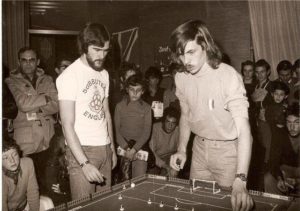
The photo above shows me playing with OO Scale against Stefano Beverini of Italy and sporting an SSG T shirt. This may have been the game that saw me banned by the English TSA.
Nowadays when I play in Malaysia or Singapore I use an OO scale team made for me by Claudio Dogali of Extreme Works in Italy. I polish the bases and spinning is no longer part of my game. How things have changed!
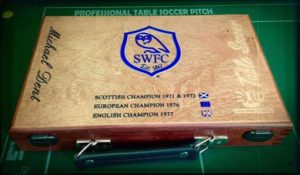
A few more quick questions:
![]() Whatever happened to some of those great English players, like Norman Gleave et al?
Whatever happened to some of those great English players, like Norman Gleave et al?
![]() The big names in my day were Ron Russ, Tony Cornell and Terry Edge. The young guns were people like Richard Stock and Paul O’Donovan Rossa (who went on to win the English league the year that I was banned). I still hear regularly from Terry and Paul – indeed Terry used to organise a 70s Master’s tournament in New Scotland Yard in London (where he had connections) once every year. Norman played in it occasionally as did Dave Collett, Geoff Luke, Paul O’Donovan Rossa, Paul Sparks and Colin Vickers. I managed to win it once about 8 years ago with four 0-0 draws and a 1-0 win.
The big names in my day were Ron Russ, Tony Cornell and Terry Edge. The young guns were people like Richard Stock and Paul O’Donovan Rossa (who went on to win the English league the year that I was banned). I still hear regularly from Terry and Paul – indeed Terry used to organise a 70s Master’s tournament in New Scotland Yard in London (where he had connections) once every year. Norman played in it occasionally as did Dave Collett, Geoff Luke, Paul O’Donovan Rossa, Paul Sparks and Colin Vickers. I managed to win it once about 8 years ago with four 0-0 draws and a 1-0 win.
![]() What’s your view on efforts to spread the game in Asia?
What’s your view on efforts to spread the game in Asia?
![]() Singapore seems very vibrant and I have good hopes for their development. In Malaysia we are attracting younger players but we really need more adults to carry the sport forward. Jamie Kong is doing his best and has organised a couple of big tournaments and gained both sponsorship and good press coverage, we even got the Minister of Sport to appear at our prize giving! But at the moment we just do not have the critical mass to get moving. I would love to be part of a South-East Asia international tournament involving Singapore, Indonesia and Malaysia in the future. And of course, in Australia … I have never been to Melbourne.
Singapore seems very vibrant and I have good hopes for their development. In Malaysia we are attracting younger players but we really need more adults to carry the sport forward. Jamie Kong is doing his best and has organised a couple of big tournaments and gained both sponsorship and good press coverage, we even got the Minister of Sport to appear at our prize giving! But at the moment we just do not have the critical mass to get moving. I would love to be part of a South-East Asia international tournament involving Singapore, Indonesia and Malaysia in the future. And of course, in Australia … I have never been to Melbourne.
![]() Have you seen any tournaments recently?
Have you seen any tournaments recently?
![]() The only tournaments I see and play in now are in Singapore, and even then only occasionally. I have played a few of the modern stars – Kaspar Bennet for example — and at their game I have no chance. I also played in a Scottish Open a couple of years ago. I find that my touch is still there – but my shooting is no-where near as accurate as it once was.
The only tournaments I see and play in now are in Singapore, and even then only occasionally. I have played a few of the modern stars – Kaspar Bennet for example — and at their game I have no chance. I also played in a Scottish Open a couple of years ago. I find that my touch is still there – but my shooting is no-where near as accurate as it once was.
![]() What was the biggest difference between the flats game and 00, and pre-polish and polished games?
What was the biggest difference between the flats game and 00, and pre-polish and polished games?
![]() The main difference is the game is no longer won by the spinning ability of the player, it has (to my mind) lost an essential element of creativity and skill, although that is not to say that the game now does not require high levels of skill. In the early days of OO scale much remained the same, spinning was still important – but more difficult to execute. Playing flats against OO scale players was a pain as the more solid OO scale bases made it difficult to score if they were blocking the shot, the ball often deflected high and wide. So OO scale had an advantage in defence but were more cumbersome in attack. Actually, nearly everything is very different now, the rules are different, the ball is a different (smaller) size, the tempo of the match is faster nowadays and as a result scores can be higher. Not only are the scores often higher this is achieved in a shorter period of time, the English TSL and ETF Europa Cup were all based on twenty minutes for each half. As a result it was important to play yourself into a match and fighting to preserve a One-Nil lead for 35 minutes or so was no easy task. The method of shooting and goalkeeping is also quite different. With a smaller goalkeeper and little chance of the ball lifting from a shot from a figure a long distance away from the ball narrowing the angles was more important. Nowadays the long distance chip means that not extending the goalkeeper out too far is important.
The main difference is the game is no longer won by the spinning ability of the player, it has (to my mind) lost an essential element of creativity and skill, although that is not to say that the game now does not require high levels of skill. In the early days of OO scale much remained the same, spinning was still important – but more difficult to execute. Playing flats against OO scale players was a pain as the more solid OO scale bases made it difficult to score if they were blocking the shot, the ball often deflected high and wide. So OO scale had an advantage in defence but were more cumbersome in attack. Actually, nearly everything is very different now, the rules are different, the ball is a different (smaller) size, the tempo of the match is faster nowadays and as a result scores can be higher. Not only are the scores often higher this is achieved in a shorter period of time, the English TSL and ETF Europa Cup were all based on twenty minutes for each half. As a result it was important to play yourself into a match and fighting to preserve a One-Nil lead for 35 minutes or so was no easy task. The method of shooting and goalkeeping is also quite different. With a smaller goalkeeper and little chance of the ball lifting from a shot from a figure a long distance away from the ball narrowing the angles was more important. Nowadays the long distance chip means that not extending the goalkeeper out too far is important.
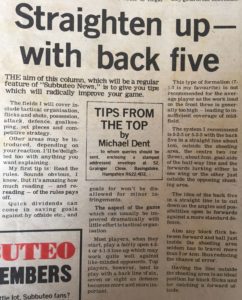
![]() What about tactics?
What about tactics?
![]() In the old days you had to play to a “recognised” FA formation, such as 4-4-2, or 4-2-4 etc. I believe I was the first person to introduce the line defence, but a lot of players accused me of cheating and not playing according to the rules. But they did not apply after KO – so I just reorganised at the first goal kick!!
In the old days you had to play to a “recognised” FA formation, such as 4-4-2, or 4-2-4 etc. I believe I was the first person to introduce the line defence, but a lot of players accused me of cheating and not playing according to the rules. But they did not apply after KO – so I just reorganised at the first goal kick!!
![]() Many thanks Mike — hope to see you in Melbourne!!
Many thanks Mike — hope to see you in Melbourne!!
